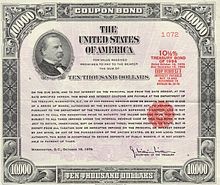 For my magic trick today, I will be resurrecting a post from over 11 years ago! That’s the last time it there was any significant interest for an individual to buy Treasury Bills instead of using a top-yielding bank account. As of 6/18/18, a 4-week T-Bill rose to a . Since T-Bill interest is exempt from state and local income taxes, your tax-equivalent yield could top 2% today.
For my magic trick today, I will be resurrecting a post from over 11 years ago! That’s the last time it there was any significant interest for an individual to buy Treasury Bills instead of using a top-yielding bank account. As of 6/18/18, a 4-week T-Bill rose to a . Since T-Bill interest is exempt from state and local income taxes, your tax-equivalent yield could top 2% today.
This is a short visual guide on creating a Treasury Bill ladder, which maximizes your liquidity. If you use the TreasuryDirect website, it now includes an option for automatic reinvestment upon maturity, which makes things even easier after the initial setup.
Quick Facts
- Treasury Bills are purchased at a discount and redeemed at the full par value. So for each $1,000 worth, you’ll pay ~$99x dollars upon issue and receive $1000 upon maturity.
- You can either buy them at TreasuryDirect.gov, or from a brokerage firm that offers a bond desk like Fidelity, Vanguard, TD Ameritrade, etc.
- Rates are set by auction, so you will not know your exact interest rate before you commit to buy. You can look at historical rates to help get you a ballpark estimate.
- 4-week T-Bill auctions are normally held on Tuesdays, and the T-Bills both issue and mature on Thursdays. Here is a list of .
- You must schedule the purchase before Noon EST on the auction date (Tuesdays), otherwise you are pushed to next week. (TreasuryDirect now allows automatic reinvestment upon maturity for up to 2 years.)
- The transfer of money to/from your bank account upon purchase/maturity is well-synchronized. That is, if one Treasury Bill matures (deposits $1,000) and another is issued on the same day (withdraws $995), your bank account should have a net positive $5 balance at the end of that day.
Visual Guide To Setting Up A Treasury Bill Ladder
Laddering is a method of purchasing that increases the liquidity of fixed term investments such as Treasury Bills. Imagine if you bought a T-Bill every week, and each one lasts for 4 weeks. After four weeks, you could simply use the proceeds of your first T-Bill to purchase your fifth T-Bill. The week after that, you could use the proceeds from your second T-Bill to purchase your 6th T-Bill, and so on forever. If you stopped buying T-Bills, you would get $1,000 back each week until all have matured.
Since each T-Bill has an investment minimum of $1,000, you would need to commit 4 x $1,000 = $4,000. If you don’t have enough, you can simply buy them at less frequent intervals. Below are four visual examples for buying them every month, every two weeks, and every week:
$1,000 Minimum – Buy a T-Bill Every Month
Assuming a discount value of $995:
Week #1: T-Bill #1 will be issued on Thursday (net taken from bank account: -$995)
Week #5: T-Bill #1 will mature (+$1,000) and T-Bill #2 will be issued (-$995) on Thursday (net: -$990)
(and so on…)
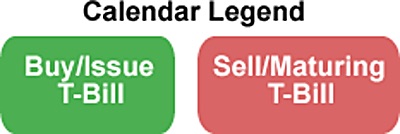
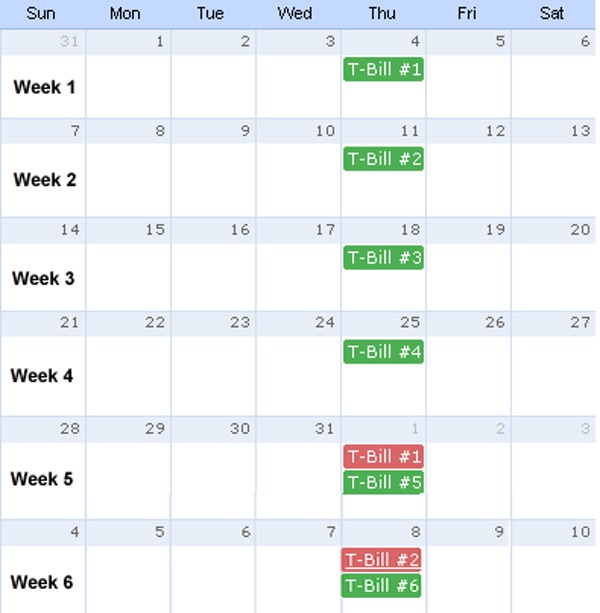
In some months, there may be a gap between the T-Bill maturing and the next one issuing, but you should never have more than $1,000 invested “outside” in T-Bills. However, you may have to wait up to 28 days for your money to come back to you.
$2,000 Minimum – Buy a T-Bill Every Other Week (Bi-Weekly)
Week #1: T-Bill #1 issued on Thursday (net: -$995)
Week #3: T-Bill #2 issued on Thursday (-$1990)
Week #5: T-Bill #1 matures, T-Bill #3 issued on Thursday (-$1985)
Week #7: T-Bill #2 matures, T-Bill #4 issued on Thursday (-$1980)
Week #9: T-Bill #3 matures, T-Bill #5 issued on Thursday (-$1975)
(and so on…)
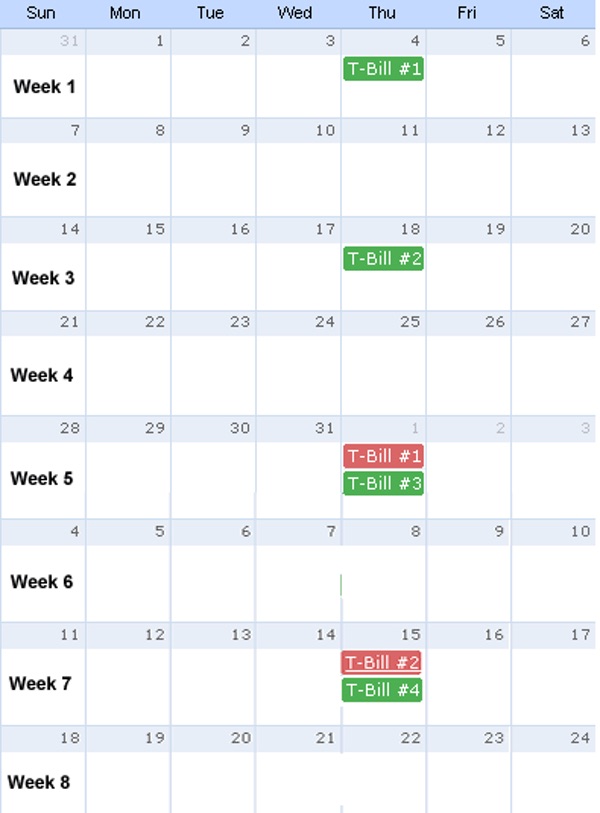
As you can see, you should never need more than $2,000 committed to T-Bills using a bi-weekly ladder. If you have $2,000, this would be a better way to set up your investments since in the worst case you can stop buying new T-Bills and get access to half your investment in 14 days once the ladder is constructed.
$4,000 Minimum – Buy a T-Bill Every Week
Week #1: T-Bill #1 issued on Thursday (net: -$995)
Week #2: T-Bill #2 issued on Thursday (-$1990)
Week #3: T-Bill #3 issued on Thursday (-$2985)
Week #4: T-Bill #4 issued on Thursday (-$3980)
Week #5: T-Bill #1 matures, T-Bill #5 issued on Thursday (-$3975)
Week #6: T-Bill #2 matures, T-Bill #6 issued on Thursday (-$3970)
Week #7: T-Bill #3 matures, T-Bill #7 issued on Thursday (-$3965)
(and so on…)
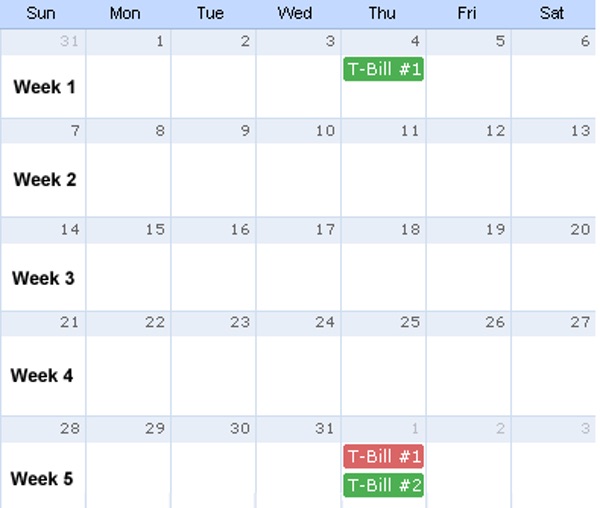
Here, you’ll never have more than $4,000 committed, and 1/4th of your money will be available in a week once the ladder is constructed.
Practical Details
If you don’t already have a preferred brokerage account, you can buy T-Bills online at TreasuryDirect.gov. Check out the for a walkthrough; It’s very similar to opening an online bank account. You will need to verify your identity with your Social Security Number, but there is no credit check. You will need a bank account as an initial source of funds.
After logging in, do not use “Purchase Express”, click on the “Buy Direct” tab on top instead, and choose “Bills”. Here is a screenshot of the entire purchase screen, including the option for automatic reinvestment (into another T-Bill of the same type and term):
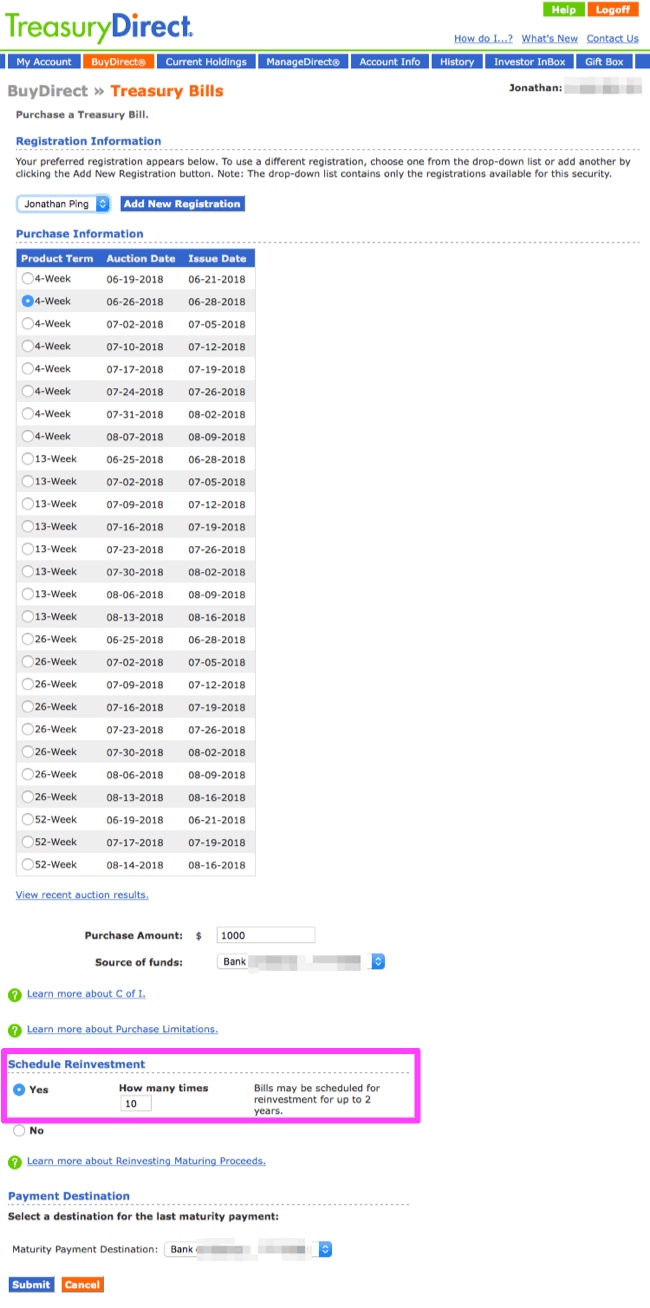
If you choose your interval correctly, everything pretty much goes on autopilot. For a 4 x $1,000 weekly ladder, you would just set up 4 purchases and have them reinvest automatically for up to 2 years. Note that I chose both the source and destination of funds to be my bank account. If you are using a savings account, remember that they are limited to 6 withdrawals per month. If you want to avoid the extra transactions at the expense of a little bit of interest, you may choose to use the “” as your source or destination account. Just think of it as a savings account that pays no interest that serves as a holding place for money. Obviously, you don’t want to keep too much in there.
Bottom line. Individuals can invest in Treasury Bills, which are Treasury Bonds with a maturity of one year or less. T-Bill interest rates are now competitive with top online bank accounts, even exceeding them in some cases due to the interest being exempt from state income taxes. Structuring them as a T-Bill ladder is a way to increase your liquidity. By creating a ladder of 4-week T-Bills maturing every week, you can always have access to 1/4th of your funds in a week, 1/2 of your funds in 2 weeks, and so on.
from .
© MyMoneyBlog.com, 2018.